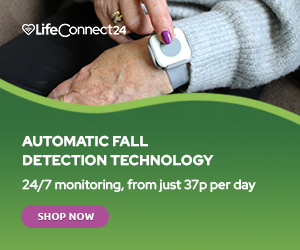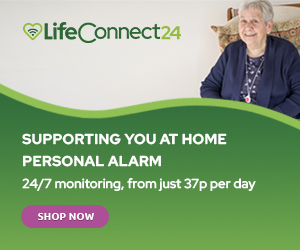As we get older, certain medical conditions, medications, and changes to our bodies can put us at risk of falling. Older people are more likely to experience a fall, whether at home or out and about. In fact, according to the NHS, around one in three adults over 65 will have at least one fall a year. Therefore, it’s important to do whatever you can to reduce your risk of falling. With this in mind, we’re sharing our top 5 ways to prevent falls at home.
1. Assess Your Home
When it comes to preventing falls at home, the first step is to assess your surroundings. The main reasons for falls at home include balance issues, muscle weakness, and sensory problems. Assess your home room by room, looking out for areas and items that could cause you to fall for any of these reasons. These could include loose rugs or carpets, dimly-lit areas, or items that you need to reach for.
A high proportion of falls occur in the bathroom. Therefore, it may be a good idea to install grab rails around the bath and shower and next to the toilet. This is a simple, affordable way to prevent falls at home.
If you aren’t sure what to look out for as you assess your home, ask a family member or neighbour to come and help you. Your doctor may also be able to arrange a professional home assessment for you. Make sure you are having regular check-ups with your GP and talk to them about your concerns.
After assessing your home, you may decide that it’s time to downsize or move to a bungalow. Just like the bathroom, the stairs are a common site for falls at home. A bungalow eliminates that risk altogether.
2. Remove Hazards & Take Action
You’ve completed your home assessment. Now it’s time to remove any hazards around your home. In most cases, this just requires a few simple changes which will be easy and inexpensive to make. Removing these hazards will automatically reduce your risk of falling at home, helping you stay safe and independent. Here are some examples of hazards in the home and how to fix them:
- If you have any rugs in your home, make sure to secure them firmly in place. Use double-sided carpet tape to make sure your favourite rug is not a tripping hazard.
- If necessary, reorganise your kitchen cupboards so that the items you use most are within easy reach. Make sure you don’t have to stretch up too high or bend too low on a regular basis.
- Install grab rails in the bathroom to prevent falls. In addition, fit a rubber mat on the floor of your bath and/or shower. Bathroom surfaces can easily become very slippery – grab rails and rubber mats help to reduce your risk of falling in the bathroom.
Remember, if you’re struggling to move around your home safely, it may be time to move house.
3. Help with Mobility
If you are struggling with your balance and general mobility in your home but you don’t want to move house, don’t despair. There are plenty of products that can help you live safely and prevent falls at home.
For lots of older people, the main obstacle is the staircase. Whether you’re having balance issues or you simply get out of breath, using the stairs can be hazardous. Everyone should have handrails or bannisters on both sides of the stairs. Make sure these are installed securely at elbow height – and make sure you hold onto them every time you use the stairs.
For those who need some extra help using the stairs, a stairlift is the perfect solution. These devices allow you to take a comfy seat, press a single button and relax as the lift carries you up and down the stairs. Of course, a stairlift is a big investment, but you shouldn’t let the cost put you off. Contact your local council to apply for a Disabled Facilities Grant. This is a government grant which can help you pay for your stairlift and other home adaptations. You can also buy reconditioned stairlifts, which are often much more affordable.
Similarly, there are plenty of mobility aids for the bathroom. These include bath steps, shower seats, and a raised toilet seat.
4. Assistive Technology
As the UK’s population ages, technology continues to develop. Nowadays, there are plenty of helpful devices which can keep elderly people safe and independent. Lots of this assistive technology can help to prevent falls at home.
Rushing around the home is one of the biggest causes of falls; you’re less likely to pay attention to where you’re going if you’re in a hurry. Think of situations where you might need to rush: when someone knocks at the door, or when a pot is boiling over on the stove, for example. Nowadays, you can attach a camera to your front door, with the footage coming through to your mobile device. This means you’ll have no need to rush to see who’s at the door – most devices let you speak into your smartphone to tell the person outside you are coming.
Stove alarms are great for people who may be forgetful. They work by learning how you use the cooker (to prevent false alarms) and sounding an alarm when the temperature rises but before a fire ignites.
You might also feel the need to rush to get to the telephone in time, but make sure you take your time moving around the house. Did you know that your Lifeline alarm can be programmed to answer the landline phone simply by pressing your pendant button?
5. Prevent Falls at Home by Planning Ahead
It may be that right now you’re medically well and don’t struggle with your balance around the home. However, as the old saying goes, prevention is better than cure. It’s far better to start thinking about how to prevent falls at home now, rather than waiting until a fall occurs. The fact that you’re reading this article is a great sign – it means you’re ready to take action and keep yourself safe at home.
After assessing your home for fall risks, you might identify a few hazards that could be fixed. Even if these changes aren’t needed right now, they might become necessary soon. Be proactive and fix these problems before they become even more dangerous.
One of the most effective ways to prevent falls at home is to stay active. Regular exercise can improve your balance, coordination, and muscle strength, all of which are crucial for preventing falls. Furthermore, you should go for regular eye tests, stay hydrated, and wear shoes that fit well and have sturdy, gripping soles.
Read More: Leading Causes of Falls in the UK
Stay Safe At Home with a Personal Alarm
By taking these simple steps to prevent falls at home, you’ll not only be protecting yourself. You’ll also be helping to reduce strain on the NHS. Falls cause the vast majority of hip fractures among the elderly. Hip fractures and related care cost the NHS more than £2 billion every year.
The tips we’ve shared today will help you prevent falls at home. However, we know that accidents still happen. Therefore, it’s important to have a plan in place in case you do fall. Lifeline alarms are an affordable and reliable way to protect yourself at home. If you have a fall, you’ll be able to press a button on your Lifeline pendant. This will raise an alert with our Emergency Response Team, who will arrange help for you straight away.
For more information regarding our life-saving personal alarm service please get in touch by giving our friendly team a call on 0800 999 0400. Alternatively, you can send an email to info@lifeconnect24.co.uk and we’ll respond as soon as possible.
You can order your new Lifeline alarm online today.
Read our Top Tips for Staying Safe at Home
Editor’s Note: This article was updated on 27th April 2022 to reflect current information.


